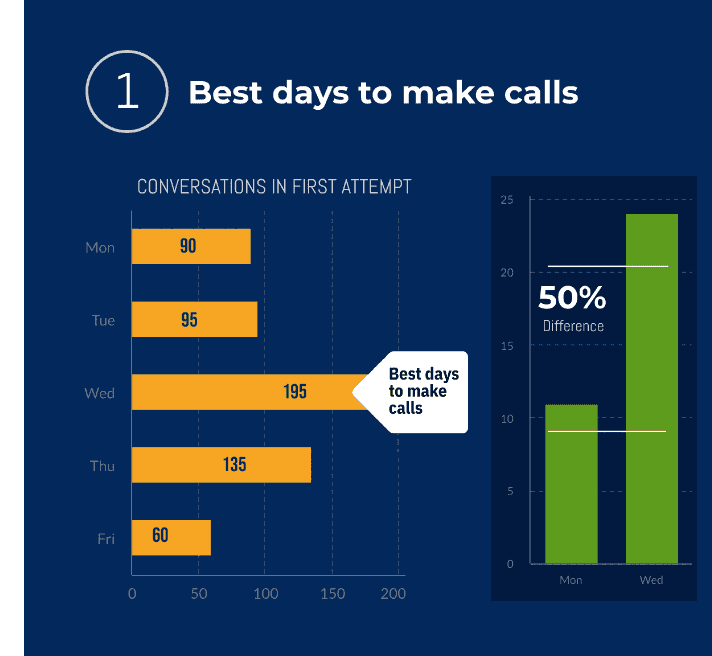An Agent is Never Better Than Their Contact Rate

- January 10, 2023
On average, a B2B sales rep makes 35 calls every day and spends around 55 minutes speaking to prospects.
So if one call takes an average of 7.5 minutes, a salesperson can only have seven successful conversations despite making 35 calls. This is the average contact rate for most sales teams.
Furthermore, the telecom world is quickly changing, thanks to the privacy regulations that make it even harder to call prospects, decreasing the contact rate.
However, these new developments shouldn't bar you from hitting your sales quota.
In this guide, we’ll go all-in on contact rate to describe what it is, how it affects your sales team performance, and how to increase it.
What is Contact Rate?
As hinted above, the contact rate is the total number of calls you’ve had divided by the number of successful conversations, then multiplied by 100%.
For example, if you called 20 leads but only managed to speak to 10, your contact rate is 50%.
Here’s an image showing how to calculate it.

Now, don’t confuse contact with conversion rates.
There’s a difference. Conversion rate is the actual number of customers who have purchased your product due to your cold-calling campaigns.
But the conversion rate is dependent on the contact rate. The higher the contact rate, the higher the conversion rate.
Again most people use connection rate and contact rate interchangeably. Connection rate is when someone answers your cold call but immediately hinges up, or your cold call reaches the prospect’s voicemail.
Why Contact Rates Matter
A high contact rate signifies that your campaign is paying off and that your SDR’s cold-calling techniques are working. So you have to maintain what you’re doing if you’re getting credible results.
On the other hand, a low contact rate means that your telemarketing campaign is experiencing serious issues that prevent sales reps from having rich conversations with prospects.
Many factors might contribute to this, which include:
- Poor sales techniques
- Software misconfiguration
- Inaccurate call lists
- Poor outdated technologies
While these issues result in low conversion rates, they also frustrate sales reps because they can’t get better results for the time invested.
Therefore, it’s critical to check your contact rate occasionally to determine if there’s a decline. If there’s any issue, address it before it gets out of hand.
Here are six tips to boost your contact rate.
1. Qualify your contact list
You might be the most skilled sales rep on your team, but if you keep reaching out to the wrong prospects, you’ll always have a poor contact rate.
While cold calling is a numbers game, casting your net too wide on low-quality prospects means you’ll invest so much time and resources only to miss your sales targets.
The trick is to have a hyper-targeted list made up of the most qualified prospects that have shown interest in your product/service.
Qualifying prospects begin by creating an accurate buyer persona. It gets more specific as you move down the sales funnel.
Regardless of the sales funnel stage, having the correct data is what determines if you have the right people on your contact list.
You want to know data points like job title, company size, revenue, and industry. You then have to move to granular details like the customer's lifetime value, key motivation and buying triggers, product use, and referral potential.
These data points allow you to notice common characteristics among customers, which help you create a highly targeted prospect list.
2. Local dialing
Research from Software Advice found that people are four times more likely to answer calls from local numbers than toll-free numbers.
For example, when you receive an anonymous phone call from a local number in your state, you’ll assume it’s your dentist, pharmacist, or accountant. The expectation will be pretty different when it’s a toll-free number. You’ll probably think it’s a company Robo-dialing you; hence ignore it.
Sales teams can use local match spoofing’ to make their calls appear local. But we must agree that developing trust after that with target prospects will be a concern.
The same survey found that while local dialing increases the contact rate, 44% of customers hang up.
That may be discouraging. However, Craig Borronwski, who did the survey, continues to say that the study didn’t take many responses; hence you should take the result with a grain of salt.
Why?
It's not easy for someone to quickly hang up on a phone once they realize it’s not from their local area. More people are patient and will gladly listen to what you have to say as long as you do in-depth research about them.
Where does that leave us?
Use local dialing if you have to or add an enhanced caller ID which will display your business name on the prospect's phone. This lets prospects know it’s an actual business from out of state, reducing their urge to reject the call.
3. Keep Track of Your Caller ID Reputation
Local dialing is one way to slip through the cracks into your prospect's phone.
But as said earlier, quite a small number of prospects won’t be happy with your local match spoofing and will hang up.
To add salt to the injury, some will further block and flag your numbers or, even worse, report your number to the FCC. You might waste more time and resources trying to clear your name.
Therefore, you need a caller ID reputation tool that checks your local number against blacklisting and blocking apps. With the software, you can know if your numbers have been compromised and if there are chances of ruining your company’s reputation.
This is because if you keep using blocked numbers, you lose the ability to local call prospects in an entire geographical area, even if you’ve invested so much in collecting leads and nurturing them.
So ensure that you have a caller ID reputation before you start local calling to keep all the numbers legitimate and clean.
The best part?
Some caller ID reputation tools integrate with carriers like Twilio, meaning you can purchase and use many phone numbers from different geographical areas without worrying about getting blocked.
4. Call at the right time
Finding the best time to call prospects is an effective way to boost contact rates. But it’s easier said than done.
Why?
Determining the time at which prospects are willing to hear your pitch is a matter of trial and error.
Luckily many studies and surveys have decoded the times that most prospects are willing to receive your calls.
- Wednesday and Thursday - A study by Gong in 2020 (and more sources) found that the middle of the week is the best time to make cold calls.
Mondays and Tuesdays mark the start of the week. Prospects are busy planning their weekly operations and hence won’t have time to listen to pitches.
On Fridays, prospects are gearing up for the weekend. They don’t want to get started on another relationship with salespeople.

This leaves us with Wednesday and Thursday. Prospects are in work mode and can quickly get back to your pitch in case they have to consult with the management team.
- 10:00 AM - 12:00 noon and 1:00 PM to 3:00 PM- Late mornings and early afternoons are the best time to call prospects. These are active working hours as prospects are in the office and done with most of their meetings.
But that might vary are some people tend to work more in the morning and don’t want to be disturbed, so they put their phones on silent mode. Others prefer to work in the noon hours.
These are the best time to call based on time and the day of the week.
However, the best moment to call prospects based on sales best practices is as fast as possible.
It should be at most 30 minutes after the lead hits your CRM. Why? Prospects have shown their problem is urgent, so they filled out your lead form, and they expect a quick solution.
You can even make three phone calls if they don’t pick up. Most people tend to ignore phone calls from unknown numbers.
But calling multiple times will indicate that the call is essential hence they’ll be more likely to answer.
5. Use lead scoring
Lead scoring is a surefire way to always reach out to the most qualified prospects.
With lead scoring, you assign “value” points to each lead your sales teams generate from their cold calls.
You’ll later use these values to determine which prospects to contact in your next cold-calling campaign. In a nutshell, lead scoring gives you a prospect’s probabilistic buying intention.
Here’s how lead scoring works.
Step one: Look at your past prospects who became customers.
Step two: Determine what they have in common.
Step three: Check all the prospects that didn’t become customers and the reason behind their decisions.
Step four: Give points to each trait of the prospects that became actual customers.
There are two types of lead scoring:
-
Implicit lead scoring: This involves sorting out prospects by checking their behaviour, like website visits, email engagement, and interactions in the marketing funnel, like attending a virtual event.
-
Explicit lead scoring: This is based on the data you’ve got directly from prospects. These include traits like industry, location, job title, and company size. These are factors you’ll consider the next time you fill your leads list for cold calls.
Creating a lead scoring checklist might seem complicated due to the large amounts of data you must analyze. Luckily, you have significant and valuable resources right before you.
The first is the sales team, who are the first contact points with all prospects. They have a rough idea of the attributes that make prospects customers.
Furthermore, existing customers also have unique details that even your sales team might not know. Conduct customer interviews to understand what made them make a buying decision. Note everything down and make them a point of reference when researching prospects for your leads list.
6. Use the right dialer software
If you’re still calling prospects manually by dialing their phone numbers one by one, then you’re still left in the 90s.
Most sales teams use power dialers to boost their productivity and save time. The tools allow you to call leads automatically using a preset list of prospects' phone numbers on a CSV file or CRM tool.
The tool connects you to a prospect once there is a live connection. When the conversation ends, the sales dialer automatically calls the next person on the list.
However, more tools do more. For example, Myphoner’s cold-calling software lets you record all your calls, which we retain for up to 90 days.
Furthermore, we give you access to local numbers in more than 60 countries. This gives you room to seal trust with prospects which increases your conversion rates.
The goal of the power dialer is to help you make more calls, which means more conversations and, ultimately, more revenue.
Imagine what could happen if you increase your cold calls by 30%. Of course, that would mean you’re likely to improve your ROI by 30%.
Sales dialers not only boost your contact rates. Other benefits include:
- Reduce prospect calling costs and increase sales
- Enhances a personalized customer experience
- Ensures better targeting
- Motivates sales reps due to the productivity boost
- Better quality management
Final thoughts
Cold-calling success depends on many factors rather than your sales agent's technical skills. However, most sales managers rarely look at their contact rates which might slow your team’s performance
To avoid low contact rates, you must do routine checkups to determine where the mistakes are coming from. Once done, you can use our tips above to ensure your contact rates are at optimal levels.

Written by
Jeppe Liisberg
Jeppe Liisberg is a forward-thinking entrepreneur and software developer who has built and contributed to multiple successful startups. With a philosophy centered on creating focused, specialized solutions that excel at solving specific challenges, Jeppe founded Myphoner after identifying a critical gap in the market for effective cold calling software.
"I believe that exceptional software should solve one core problem extraordinarily well rather than attempting to be everything for everyone," says Jeppe. "After years in the trenches as an entrepreneur, I couldn't find a cold calling solution that truly met the needs of small businesses and sales teams—so I built Myphoner to fill that void."
Today, Jeppe remains personally invested in Myphoner's success and customer satisfaction, personally welcoming new users and actively responding to feedback. This hands-on approach ensures that Myphoner continues to evolve based on real user needs while maintaining its commitment to simplicity, effectiveness, and affordability.
Connect with Jeppe on LinkedIn or reach out directly at jeppe@myphoner.com.
Related articles

Industry Related
How to hire your next award-winning sales officer
If you think that hiring a sales representative is as easy as cooking a batch of chocolate chip cookies, you are making a mistake that may be very costly. Learn why.
November 24, 2022

Industry Related
Real Estate Cold Calling Insider Guide & Best Practices
Real estate cold calling plays an essential role in lead generation. With the right tools, cold calling can transform your real estate business for the better.
November 6, 2022

Industry Related
B2B Telemarketing Insider Guide & Best Practices
Cold calls might have a reputation for being tedious or ineffective, but that’s only the case when you don’t know how to do it effectively.
November 2, 2022